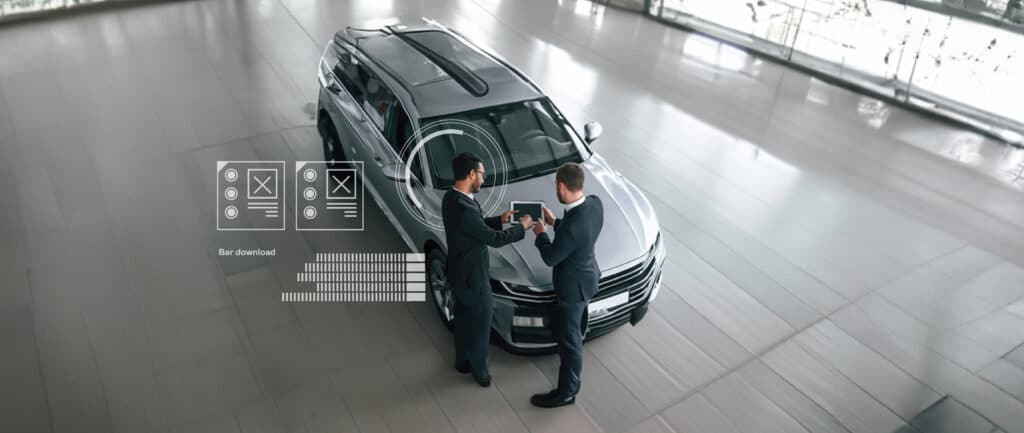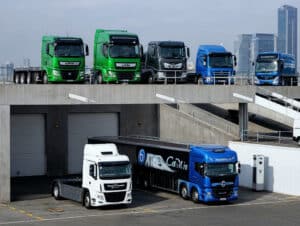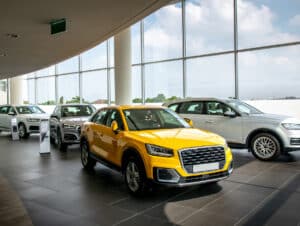Ten years ago, as a Branch Manager for a major bank, your day probably started with a visit to your office. You’d review your appointments, catch up on emails, and perhaps log into the bank’s mainframe to check your branch’s performance.
Do bank branch managers even exist anymore? Are there still banks on our streets?
We all still have bank accounts. We can withdraw cash 24/7, and buy and sell products whenever we want, without waiting for the bank to open. All we need is a mobile phone or a PC with internet. Banks, in turn, need to provide these services with a data center from a cloud provider, vast interconnectivity developed by experts, and a massive amount of secure IT infrastructure, probably managed by the bank itself!
The finance and insurance sector, one of the oldest industries, has undergone more fundamental changes in the last few decades than in the last few centuries!
A shift in automotive retail
Now, a similar transformation is happening in automotive retail.
Today, most automotive Dealer Principals, Sales Managers, or Aftersales Managers sit in large, often OEM-branded car dealerships or workshops located on main streets to maximize customer foot traffic. They log into OEM systems to configure and order vehicles and their own IT systems to handle tasks like employee salaries or financial reporting.
These systems have been in place for years, often hidden in a ‘spare office’ at the back of the dealership. Known as Dealer Management Systems (DMS), they’ve evolved to support specific automotive operations and OEM requirements. Dealers have been bound by OEM contracts, limiting their ability to innovate independently.
A lot of expertise and knowledge sits within these dealerships, which have accumulated over the decades. These experienced individuals probably selected or implemented the DMS ten years ago, but they might not have chosen the Enterprise Resource Planning (ERP) system for financial accounting, human resources, or Customer Relationship Management (CRM) – if they even have one. Two separate environments are being managed by different organizations within the dealership. 
The challenges of automotive legacy systems
As the DMS market globalizes, it has become commoditized and highly price-sensitive. Legacy DMSs support OEM integrations and processes, but even OEMs struggle to adopt new technologies like modern digital retailing methods due to these very systems. Generative AI is a hot topic, and Annata’s A365 Automotive Cloud Platform is one of the few platforms that comes with built-in generative AI through Microsoft’s Copilot.
ERP systems are dominated by well-known global players, growing in complexity and breadth. They now offer solutions for Point of Sales (POS), human resources, and procurement across various industries. However, for automotive retailing, many dealers still rely on separate ERP, DMS, and other specialized IT solutions, complicating enterprise-wide management and hindering new technology deployment. Imagine trying to leverage generative AI across multiple IT systems – it’s a logistical nightmare!
Breakthrough moments in automotive dealerships
Occasionally, we see a breakthrough moment. For instance, a CIO of a major European dealer group realized he could manage multiple OEM brand businesses with a single cloud-based platform, cancel his ERP contract for Finance & Accounting and HR management, simplify CRM capabilities, and create a professional customer contact center. This decision led to clarity, simplification, and a future-oriented plan embraced by the company’s shareholders!
These moments of clarity point to the value of integrating ERP and DMS into a unified platform. Our A365 solution, built on Microsoft’s Dynamics 365 and other technologies from the Microsoft ecosystem including Azure, Power Platform, Copilot, and Dataverse, offers a future-ready solution for the automotive industry.
The future of automotive retail
Let’s shift gears. We’ve talked about the IT and business impact of these changes. What about the changing demands of automotive customers?
The days of physically visiting a dealership, and hoping to speak to a salesperson who understands your unique needs, are fading. We can now configure, visualize, and even purchase a new car online from our phones, tablets, or smart TVs. We might visit a dealership for a test drive or to collect our purchase, but if we’re satisfied, we might never return. 
With the rise of autonomous driving and generative AI, the future of vehicle maintenance could soon become fully automated and the location of the workshop becomes irrelevant! Imagine your car booking its own service appointment, driving itself to the workshop, and being back in its parking space ready in time for you to drive to your first appointment the next morning!
This is incredibly convenient for customers, saving them time and requiring almost no effort. It’s also a win for dealers, as it enables 24/7/365 operations and improves facility utilization for both dealers and workshops.
As new vehicle sales face pressure from macroeconomic factors and the rise of OEM direct-to-consumer (D2C) sales channels, aftersales are becoming even more important for dealers. To stay on top of revenue targets, dealers need to double down on aftersales or find new ways to bring in revenue. Offering around-the-clock service for both traditional and self-driving vehicles presents a substantial growth opportunity. However, this also introduces potential challenges, such as managing higher costs due to extended hours or additional shifts.
While the jury is still out on whether this automation will create a true win-win scenario for both dealers and customers, it’s clear that significant changes in aftersales operations will be necessary to adapt to this evolving landscape.
This shift raises a pressing question: Is the automotive retail industry heading toward a future where traditional dealerships are phased out? Would we see OEMs sell directly to customers, with dealerships transforming into brand-experience centers? Just as banking has evolved through technology, the automotive retail sector is poised for a similar transformation.
We’re already seeing the emergence of integrated solutions like A365, which address the needs of both today’s and tomorrow’s automotive businesses. Single-platform solutions offer synergies and operational efficiencies, enabling dealerships to streamline processes and enhance customer experiences. For example, AI-driven systems like a Copilot-assisted service appointment tool could optimize scheduling by ensuring workshop capacity, skills availability, and the right parts are on hand—ultimately delivering a seamless customer experience.
Opportunities in the automotive industry
Looking further ahead, moving upstream to compete directly with OEMs means going head-to-head with large, well-resourced organizations—a daunting prospect. But moving downstream and tapping into the vehicle data ecosystem might present the most promising business opportunities for Annata and its partners, including importers, distributors, and dealer groups.
Vehicles today generate an enormous amount of data, attracting attention from OS providers, chip manufacturers, and app developers. We’re already seeing control unit suppliers offering new services beyond managing engines and entertainment systems. The sheer volume of data generated and processed by today’s vehicles is astounding—almost as impressive as the computing power within the vehicles themselves!
Now, imagine a future where your vehicle predicts when it needs a repair, software update, or maintenance. It could book itself into a workshop with available capacity, skilled technicians, and the necessary parts—whether it’s 11 p.m. on a Sunday or any other time. Autonomous vehicles don’t care about the time; they just ensure your car is ready when you need it. Sound familiar? It feels like we’re coming full circle!
If you’re stuck with a legacy DMS, locked into a long-term ERP contract, or held back by outdated IT and business processes, it’s time to rethink your strategy. If your new vehicle sales are in decline due to D2C launches, or you’re facing reduced demand, growing micro-mobility, or operational inefficiencies like idle service technicians and aging parts inventories, it’s time to take action. If your marketing team is struggling to attract new customers or generate additional revenue from existing ones, it’s time to consider a new approach to secure your business’s future.
“If all you have is a hammer, everything looks like a nail.” If your next technology investment is guided by the same DMS or ERP-based checklist you’ve always used, you’ll end up with more of the same. Instead, why not think differently?
As a CIO, your goal is to simplify your IT landscape, reduce vendor complexity, and standardize solutions to deploy new technologies and open up new business opportunities. As an Aftersales Manager, you want to deliver the best customer experience so they keep coming back for service or aftermarket accessories. As a Dealer Principal, your priority is to protect shareholder value by sustaining current revenue, growing new revenue streams, and improving margins through operational efficiency and customer retention.
At Annata, we offer solutions that build on your existing business. As a Microsoft Inner Circle member, we have proven capabilities to develop business applications on top of leading enterprise solutions.
For more information and to schedule a personalized session tailored to your automotive retail needs, reach out to us today. Alternatively, explore our A365 Digital Experience Center for an immersive overview to learn how A365 can power new possibilities for your automotive business.
About the writer
Phillip Parfitt is a pivotal member of Annata’s Automotive industry team, bringing a wealth of entrepreneurial expertise, extensive international experience, and strategic vision to the forefront. Phillip’s passion lies in ecosystems, the commercialization of innovation, and crafting “win-win-win” solutions. Phillip’s career includes notable roles in CDK Global, COX Automotive, Incadea, and Keyloop. Over the years, Phillip’s experience has granted him a front-row view of the industry’s shift towards a more digitally-centric approach in automotive retail.
Disclaimer
The views and opinions expressed in this article are those of the author, Phillip Parfitt. The content provided is intended for informational purposes only and should not be construed as professional advice or endorsement. The author’s insights are based on personal experience and industry knowledge, and readers are encouraged to conduct their own research and consult with relevant experts before making any business decisions.












